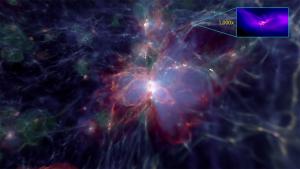Blog
Upon Further Examination
8 May 2023
 Advanced Visualization Lab, National Center for Supercomputing Applications
Advanced Visualization Lab, National Center for Supercomputing ApplicationsThe James Webb Space Telescope (JWST) is revolutionizing our understanding of the early universe. With a mirror larger than Hubble and the ability to observe deep into the infrared, JWST is giving us a detailed view of that period of the universe when galaxies were just starting to form. The results have been surprising, leading some to argue that they disprove the big bang. But the big bang is still intact, as a recent study shows.1
The standard big bang model for cosmology is the LCDM model, which is a universe driven to expand through dark energy (represented by Lambda in the equations), and filled with cold dark matter (CDM). It is the model most strongly supported by observational evidence thus far. But one of the things LCDM seemed to predict was that early galaxies should be small and irregular, building up through collisions to the larger galaxies we see today. This prediction came from computer simulations of the early universe.
Initial data from JWST seemed to contradict this prediction. In particular, two surveys, the JWST Advanced Deep Extragalactic Survey (JADES) and the Cosmic Evolution Early Release Science Survey (SEERS) found a handful of galaxies with redshifts z greater than 10. These galaxies are among the most distant galaxies ever observed. They are so far away we see them at a time when the universe was less than 500 million years old. Not only are these galaxies larger and more developed than expected, but they also have a high rate of star production.
This is where big bang skeptics jumped in. They argued that the galaxies are far too developed and far too active to have formed in less than half a billion years, so the big bang must be wrong.
 McCaffrey, et al
McCaffrey, et alBut rather than disproving the big bang, these findings show the challenges of simulating the early universe. The key to cosmological simulations is being able to model it in great detail. Obviously, we can’t simulate everything, so models focus on particular scales, such as a certain initial size of galaxies. The more detailed your simulation, the more accurate it can be, but the more computing power you’ll need to run it.
This recent study looked at high-resolution simulations called Renaissance, which runs on the Blue Waters Sustained Petascale Computing supercomputer at the University of Illinois. Renaissance simulations can model galaxies in the early universe ranging from as small as 10,000 solar masses to tens of millions of solar masses. It’s one of the most detailed simulations currently available.
The team looked at six galaxies from the JADES and SEERS surveys that had redshifts z > 10 and had well-measured star formation rates. When they compared these galaxies to the range of galaxies produced in the Renaissance simulations, they found there was strong agreement. The JWST observations support the LCDM big bang model.
As the JWST continues to gather data it is bound to find more observational surprises. And as this study shows, more detailed simulations will be needed to test observations. Just as JWST pushes the limits of cosmic observation, astrophysicists will need to push the limits of computer simulations to keep up.
McCaffrey, Joe, et al. “No Tension: JWST Galaxies at z > 10 Consistent with Cosmological Simulations.” arXiv preprint arXiv:2304.13755 (2023). ↩︎